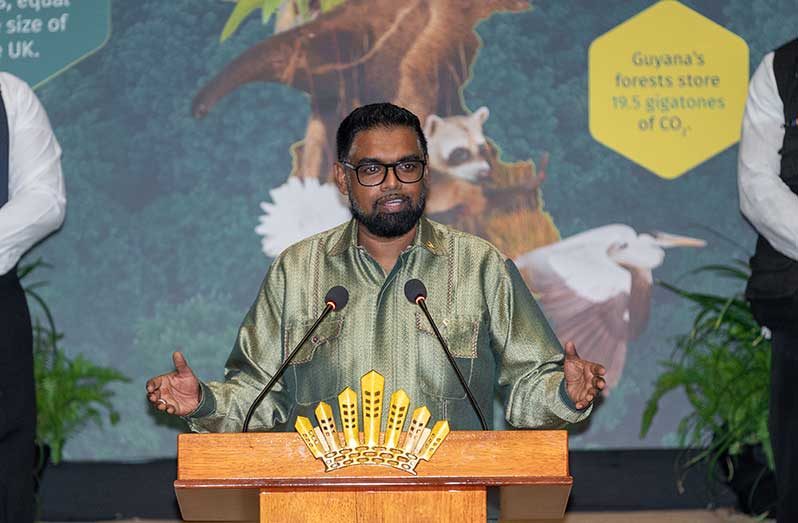–idea turned out to be an effective economic model, President Ali says
BIRTHED to give cognisance to the importance of tropical forests in the equation of climate change, Guyana’s Low- Carbon Development Strategy (LCDS) has evolved from a vision to a global policy that has set the benchmark for driving action.
This is according to the country’s President, Dr. Irfaan Ali, who, on Tuesday at the Arthur Chung Conference Centre (ACCC), opened the dialogue on a high-level discussion on “Restoring Ambition for International Climate and Development: Learning from Guyana’s Low-Carbon Development Strategy and Its Global Model for Forest Finance”.
The LCDS was first launched in 2009 with the intention of mapping out the path of a new growth trajectory in a non-polluting way. The first draft of the policy had set out an initial view on how this might be done, and outlined insights on how to stimulate the creation of a low-deforestation, low-carbon, climate-resilient economy in Guyana.
“What we saw 15 years ago was the generation of an idea; before any vision is created, there must be an idea. But when that idea is a global idea, it requires partnerships; it requires fighters for that idea; it requires backers.”
At the time, President Ali pointed out, talk of tropical forests was non-extent in the global discussions to address the effects of climate change.
In fact, it was Guyana, through the support the Kingdom of Norway, that began pushing for global recognition of forests.
“Today, our commitment to global policy making remains constant. We believe that we can help in shaping ideas and policies to find global solutions like climate, food and energy,” President Ali stated.
He noted that Guyana has been able to craft an economic model that is effective.

“Today, the LCDS is not only acknowledged as a development model, but, today, the LCDS is a part of a global strategy in combatting climate change; in developing economic strategy and positioning countries,” President Ali said.
He added: “We have really, in this journey, set the benchmark, and set the best practices when it comes to forest governance, forest management and the deployment of forest at the jurisdictional scale to meet this global challenge.”
President Ali pointed out that it is through partnerships that the country was able to further expand its LCDS as an economic model.
Joining Tuesday’s discussion was International Environmental Adviser, Former Minister of Climate and the Environment and Former Minister of International Affairs of Norway, Erik Solheim, who pointed out that Guyana has been able to solve major problems in the past, putting the nation on a low-carbon environmentally-friendly path, while fully understanding the coalition between the environment and development.
“As a part of the global south, Guyana will lobby a leading nation in the world in the ‘green’ transformation, which is a big issue in the 21st Century,” Mr. Solheim said.
Back in 2009, it was Mr. Solheim, who was the then Minister of International Development and the Environment, and then President, Dr. Bharrat Jagdeo, that inked the historic climate pact that would support the implementation of the LCDS.
In that agreement, Norway committed to providing Guyana with up to US$250 million by 2015 for avoided deforestation, once certain performance indicators were met. This agreement represented the first international commitment of financial support to the LCDS, and was the first partnership of its kind between a developed and developing country.
Later, in December 2022, the Architecture for REDD+ Transactions announced the issuance of 33.47 million TREES credit to Guyana for the five-year period from 2016 to 2020.
The Architecture for REDD+ Transactions (ART) is a global initiative that seeks to incentivise the reducing of emissions from deforestation and forest degradation (REDD), as well as restore forests and protect intact forests.
The Government of Guyana, in that same year, entered into an agreement with the Hess Corporation for the sale of carbon credits for a minimum of US$750 million between 2022 and 2032.
Fifteen per cent of the earnings from the initial disbursements was allocated to indigenous villages across Guyana, while the remaining 85 per cent was allocated to national priorities, such as climate mitigation efforts.
The government, on several occasions, has attributed these developments to its now expanded LCDS and the support of its Norwegian partners.
Although Guyana has established its own model to generate financing for its forests, challenges such as the need for a structured carbon-credit market and the world-wide trends in deforestation still see the loss of just about 20 hectares of tropical forest by the minute.
Mr. Solheim noted that many could learn from Guyana’s model to preserve its forest.
“I think the main lessons I take away from Guyana is that you need to work with the local people, and need to provide an alternative for the local people to an encroachment on the forest,” he said.
Meanwhile, Dr. Jagdeo, who now serves as Guyana’s Vice-President, pointed to the existing lack of awareness and will to preserve the forests.
“Forests are still not part of the offset mechanism,” Dr. Jagdeo said, further stating that the global community must step up to acknowledge forests as a major pillar in addressing climate change.
“Without addressing deforestation, we could never really achieve net zero. Deforestation and land degradation create about 16 per cent of greenhouse gases,” Dr. Jagdeo stated further.



.jpg)











